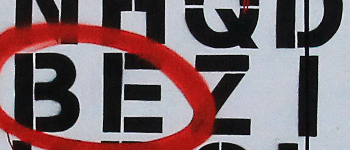My life has been captured by the story from hell. So wearying has this literary labor become, I had to pause to write another story late last year rather in the way you might take a break from a novel. A novel naturally grows as you write, but my perverse mission is to produce more and more words in an effort to produce something progressively leaner and cleaner.
I’m on the fourth complete rewrite, and although there are some clear commonalities between each version, there are vast differences too. These are effectively different stories with some shared setting and character elements.
Although this has been an immensely frustrating process, it’s also an interesting one. I have tried to use each failure constructively, and broadly speaking I believe each lesson has lead to an improved failure. It’s this learning process, as much as any commitment to a finished project, that keeps me grinding away torturing my poor parallel universe characters in new and interesting ways.
I have added new elements along the way. My characterisation is clearer, I’m more aware of my theme, and it’s better woven into the story. It seems to me, though, that the story has most benefited from things I’ve taken away.. Here are some of the things that have benefited from my reducing ray.
Characters
In previous drafts I couldn’t help but pile on the characters. And they all wanted to do stuff. I was stuck with a choice between having them do nothing but necessary little pieces of plot business, or round them out and once again bloat the story into unsellable novella territory.
When I looked hard, though, I discovered that many of the characters were actually a kind of chorus and they collapsed into a single character pretty neatly. This left me space to give the new character a bit more to do.
Even some more important and distinct characters were collapsible. This brought a duel benefit. First of all the story became that bit more compact. Secondly, I was able to combine character traits and make the composite that much more complex than the individual characters had been on their own.
Time
If only I meant less of my time by this.
In fact I mean the period over which the story unfolds. Earlier drafts played out lazily against the backdrop of a failing relationship, and this in a noirish SF piece with what is, hopefully, an explosive ending. The timescale didn’t lend itself well to tension.
Of course there’s no reason why you can’t tell a story that covers four or forty years if you want to, but you’d need to be very economical about it. Here, I wanted to stay close to the action in my scenes and use minimal narrative filler. Things soon grew flabby, with scenes written to provide information without doing much else to advance the plot.
So I transformed the long relationship into a brief, doomed affair. What’s more, I made the timeline explicit by adding a countdown. At the very start I gave my main character five days to save himself, and I made his lover an obstacle to this need. This device gave me urgency from the start, and made the story a crucible for struggle.
Plot elements
This is something of a no brainer, but really it came as a revelation. I was simply trying to do too much. Firstly I had an arc that was far too wide. It might have worked for a novel, but I was either going to bloat, or have to compress my scenes into meaninglessness. On top of that I had multiple plot lines feeding into one another. There was a murder and a rebellion story which helped propel the protagonist’s journey and motivated his nemesis too.
I cut the arc down to size. I kept most of my nice ending, but made the journey from the start a little more direct. I stripped away nice but bulky related events. Goodbye exploding car! Good riddance to the complicated business of assembling a hive personality! And things were looking much cleaner.
Premise
Yes, I did say hive personality. Don’t ask.
Now there’s nothing wrong with writing a story about that. Trouble is, my story was mainly about something else too. Again, I might have got away with this in a novel. The hive personality was actually a consequence of the story’s main conceit. But with so little space to work with, I realised that this premise had a not-only-but-also quality to it. Cutting this unnecessary addition from the core made things much less confusing, and helped me to chop out plot elements too.
Showing
This might be a tad controversial. I have fully swallowed the old show, don’t tell rule. But this is an SF story. With setting and premise important, and so little space available, an awful lot of good stories wear their exposition with pride.
I had done a reasonable job of letting the story world bleed into the reader’s comprehension, through snippets of dialogue and fragments of thought, but once again I ran out of runway pretty fast. Time either to make more runway, or just tell the reader some things already.
And now where am I? Well I haven’t finished, of course. For this draft I’ve been experimenting with more upfront planning, and I’ll soon see if my fiddling around with file cards and character interviews will bear fruit. Whether or not it’s successful, I’m reasonably sure I’m on track to a better failure.
The picture that accompanies this post was taken with a smart phone. I have destroyed three good cameras in about a year, so my experiment for now is to see what I can do with a humble phone cam. I’ll add any I like to posts occasionally.





